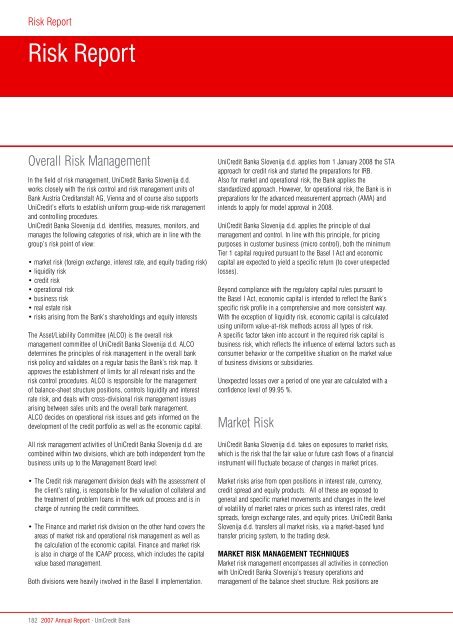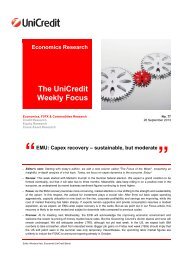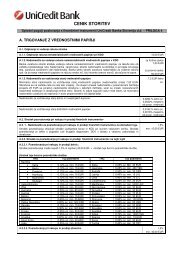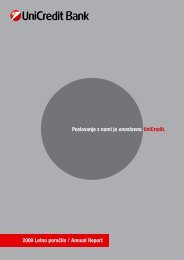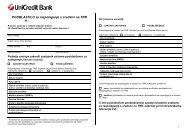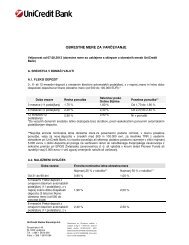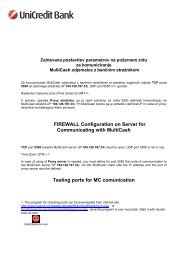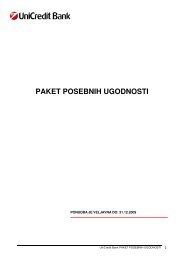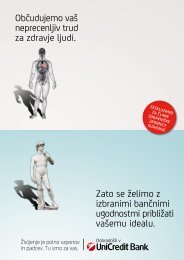Letno poroÄilo 2007 - UniCredit Banka Slovenija dd
Letno poroÄilo 2007 - UniCredit Banka Slovenija dd
Letno poroÄilo 2007 - UniCredit Banka Slovenija dd
Create successful ePaper yourself
Turn your PDF publications into a flip-book with our unique Google optimized e-Paper software.
Risk ReportRisk ReportOverall Risk ManagementIn the field of risk management, <strong>UniCredit</strong> <strong>Banka</strong> <strong>Slovenija</strong> d.d.works closely with the risk control and risk management units ofBank Austria Creditanstalt AG, Vienna and of course also supports<strong>UniCredit</strong>’s efforts to establish uniform group-wide risk managementand controlling procedures.<strong>UniCredit</strong> <strong>Banka</strong> <strong>Slovenija</strong> d.d. identifies, measures, monitors, andmanages the following categories of risk, which are in line with thegroup’s risk point of view:• market risk (foreign exchange, interest rate, and equity trading risk)• liquidity risk• credit risk• operational risk• business risk• real estate risk• risks arising from the Bank’s shareholdings and equity interestsThe Asset/Liability Committee (ALCO) is the overall riskmanagement committee of <strong>UniCredit</strong> <strong>Banka</strong> <strong>Slovenija</strong> d.d. ALCOdetermines the principles of risk management in the overall bankrisk policy and validates on a regular basis the Bank’s risk map. Itapproves the establishment of limits for all relevant risks and therisk control procedures. ALCO is responsible for the managementof balance-sheet structure positions, controls liquidity and interestrate risk, and deals with cross-divisional risk management issuesarising between sales units and the overall bank management.ALCO decides on operational risk issues and gets informed on thedevelopment of the credit portfolio as well as the economic capital.All risk management activities of <strong>UniCredit</strong> <strong>Banka</strong> <strong>Slovenija</strong> d.d. arecombined within two divisions, which are both independent from thebusiness units up to the Management Board level:• The Credit risk management division deals with the assessment ofthe client’s rating, is responsible for the valuation of collateral andthe treatment of problem loans in the work out process and is incharge of running the credit committees.• The Finance and market risk division on the other hand covers theareas of market risk and operational risk management as well asthe calculation of the economic capital. Finance and market riskis also in charge of the ICAAP process, which includes the capitalvalue based management.Both divisions were heavily involved in the Basel II implementation.<strong>UniCredit</strong> <strong>Banka</strong> <strong>Slovenija</strong> d.d. applies from 1 January 2008 the STAapproach for credit risk and started the preparations for IRB.Also for market and operational risk, the Bank applies thestandardized approach. However, for operational risk, the Bank is inpreparations for the advanced measurement approach (AMA) andintends to apply for model approval in 2008.<strong>UniCredit</strong> <strong>Banka</strong> <strong>Slovenija</strong> d.d. applies the principle of dualmanagement and control. In line with this principle, for pricingpurposes in customer business (micro control), both the minimumTier 1 capital required pursuant to the Basel I Act and economiccapital are expected to yield a specific return (to cover unexpectedlosses).Beyond compliance with the regulatory capital rules pursuant tothe Basel I Act, economic capital is intended to reflect the Bank’sspecific risk profile in a comprehensive and more consistent way.With the exception of liquidity risk, economic capital is calculatedusing uniform value-at-risk methods across all types of risk.A specific factor taken into account in the required risk capital isbusiness risk, which reflects the influence of external factors such asconsumer behavior or the competitive situation on the market valueof business divisions or subsidiaries.Unexpected losses over a period of one year are calculated with aconfidence level of 99.95 %.Market Risk<strong>UniCredit</strong> <strong>Banka</strong> <strong>Slovenija</strong> d.d. takes on exposures to market risks,which is the risk that the fair value or future cash flows of a financialinstrument will fluctuate because of changes in market prices.Market risks arise from open positions in interest rate, currency,credit spread and equity products. All of these are exposed togeneral and specific market movements and changes in the levelof volatility of market rates or prices such as interest rates, creditspreads, foreign exchange rates, and equity prices. <strong>UniCredit</strong> <strong>Banka</strong><strong>Slovenija</strong> d.d. transfers all market risks, via a market-based fundtransfer pricing system, to the trading desk.Market risk management techniquesMarket risk management encompasses all activities in connectionwith <strong>UniCredit</strong> <strong>Banka</strong> <strong>Slovenija</strong>’s treasury operations andmanagement of the balance sheet structure. Risk positions are182 <strong>2007</strong> Annual Report · <strong>UniCredit</strong> Bank


